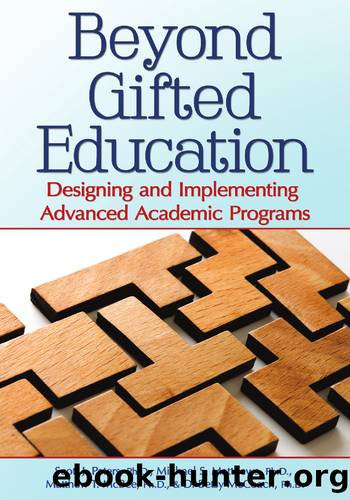Beyond Gifted Education by Scott J. Peters

Author:Scott J. Peters
Language: eng
Format: epub
Publisher: Taylor and Francis
The Process
The next question, then, regards developing the process for selecting students for the program. The general principles of defensible identification discussed at length in Chapter 3 apply here. The concept of potential risk again becomes salient; we review risk in the context of acceleration below before explaining why there is less risk inherent to enrichment programming.
For acceleration programs, the potential for risk is relatively high, with more risk being involved for more radical forms of acceleration. This is because in many cases there is no easy way for a student who drops out of an accelerated program to go back and obtain instruction in the grade-level content that was missed because of the acceleration. Affective or motivational damage in backing out of an accelerated placement could also present additional risk. Also, there may be considerable organizational and bureaucratic headaches involved in âundoingâ a studentâs accelerated placement. For example, if a student has skipped a grade but is failing to thrive, it may be very difficult to move him back to his original placement in the middle of the year without significant disruption. In such a case, there may be difficulties in finding the student space in his previous classroom; determining where the âholesâ might be in the studentâs grade-level content knowledge, and determining how those holes can be filled; evaluating the studentâs performance in the new setting when much of the work has been missed; and, of course, the social upheaval involved. For those reasons, acceleration programs typically have high potential risk. Therefore, when designing the identification process for selecting students for those programs, it makes sense to be more accepting of false negatives than false positives. Of course, placement errors are inevitable, but, in this context, failing to accelerate a capable student may be less dire than accelerating a student who proves to be incapable of it.
Enrichment programming typically has a much lower potential for risk than acceleration does. The risk to the student in enrichment usually occurs because students are generally either exempted from instructional time and content or have progressed through that content more rapidly (via compacting or telescoping) in order to make time for the enrichment program in the busy school day. The primary risk to the student is that he spends his time inefficientlyâin other words, the hours he spends learning the mathematics underlying the concept of signal to noise would have been better spent engaging in further practice of grade-level math or science content. If this proves to be the case, then it is usually minimally disruptive (from an administrative standpoint) to discontinue the studentâs participation in the enrichment program or to restructure it in such a way as to make it more effective. From the studentâs perspective, the risk of undoing a placement is also relatively small because it may simply involve being in a different group or classroom during the time scheduled for the enrichment programming. Because enrichment programs typically have low potential risk, their identification procedures should be biased toward false positivesâthey should be more focused on inclusion than on exclusion.
Download
This site does not store any files on its server. We only index and link to content provided by other sites. Please contact the content providers to delete copyright contents if any and email us, we'll remove relevant links or contents immediately.
| Behavioral Disorders | Communicative Disorders |
| Gifted Students | Inclusive Education |
| Learning Disabled | Mentally Disabled |
| Physically Disabled |
The Art of Coaching Workbook by Elena Aguilar(50996)
Trainspotting by Irvine Welsh(21521)
Twilight of the Idols With the Antichrist and Ecce Homo by Friedrich Nietzsche(18508)
Fangirl by Rainbow Rowell(9100)
Periodization Training for Sports by Tudor Bompa(8171)
Change Your Questions, Change Your Life by Marilee Adams(7638)
This Is How You Lose Her by Junot Diaz(6800)
Asking the Right Questions: A Guide to Critical Thinking by M. Neil Browne & Stuart M. Keeley(5651)
Grit by Angela Duckworth(5525)
Red Sparrow by Jason Matthews(5391)
Paper Towns by Green John(5092)
Room 212 by Kate Stewart(5041)
Ken Follett - World without end by Ken Follett(4647)
Housekeeping by Marilynne Robinson(4349)
The Sports Rules Book by Human Kinetics(4298)
Double Down (Diary of a Wimpy Kid Book 11) by Jeff Kinney(4208)
Papillon (English) by Henri Charrière(4199)
The Motorcycle Diaries by Ernesto Che Guevara(4016)
Exercise Technique Manual for Resistance Training by National Strength & Conditioning Association(3958)
